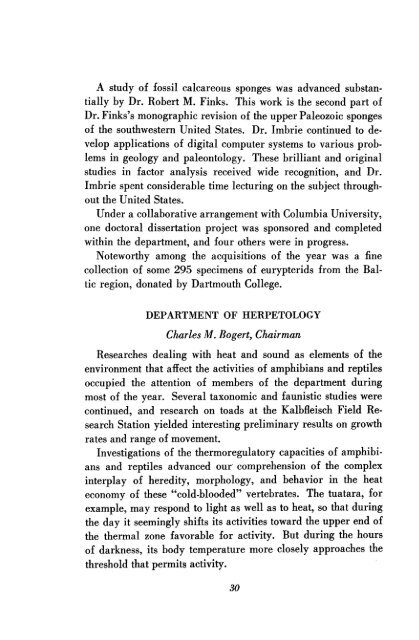1961-1962 - American Museum of Natural History
1961-1962 - American Museum of Natural History
1961-1962 - American Museum of Natural History
Create successful ePaper yourself
Turn your PDF publications into a flip-book with our unique Google optimized e-Paper software.
A study <strong>of</strong> fossil calcareous sponges was advanced substantially<br />
by Dr. Robert M. Finks. This work is the second part <strong>of</strong><br />
Dr. Finks's monographic revision <strong>of</strong> the upper Paleozoic sponges<br />
<strong>of</strong> the southwestern United States. Dr. Imbrie continued to develop<br />
applications <strong>of</strong> digital computer systems to various problems<br />
in geology and paleontology. These brilliant and original<br />
studies in factor analysis received wide recognition, and Dr.<br />
Imbrie spent considerable time lecturing on the subject throughout<br />
the United States.<br />
Under a collaborative arrangement with Columbia University,<br />
one doctoral dissertation project was sponsored and completed<br />
within the department, and four others were in progress.<br />
Noteworthy among the acquisitions <strong>of</strong> the year was a fine<br />
collection <strong>of</strong> some 295 specimens <strong>of</strong> eurypterids from the Baltic<br />
region, donated by Dartmouth College.<br />
DEPARTMENT OF HERPETOLOGY<br />
Charles M. Bogert, Chairman<br />
Researches dealing with heat and sound as elements <strong>of</strong> the<br />
environment that affect the activities <strong>of</strong> amphibians and reptiles<br />
occupied the attention <strong>of</strong> members <strong>of</strong> the department during<br />
most <strong>of</strong> the year. Several taxonomic and faunistic studies were<br />
continued, and research on toads at the Kalbfleisch Field Research<br />
Station yielded interesting preliminary results on growth<br />
rates and range <strong>of</strong> movement.<br />
Investigations <strong>of</strong> the thermoregulatory capacities <strong>of</strong> amphibians<br />
and reptiles advanced our- comprehension <strong>of</strong> the complex<br />
interplay <strong>of</strong> heredity, morphology, and behavior in the heat<br />
economy <strong>of</strong> these "cold-blooded" vertebrates. The tuatara, for<br />
example, may respond to light as well as to heat, so that during<br />
the day it seemingly shifts its activities toward the upper end <strong>of</strong><br />
the thermal zone favorable for activity. But during the hours<br />
<strong>of</strong> darkness, its body temperature more closely approaches the<br />
threshold that permits activity.<br />
30

















